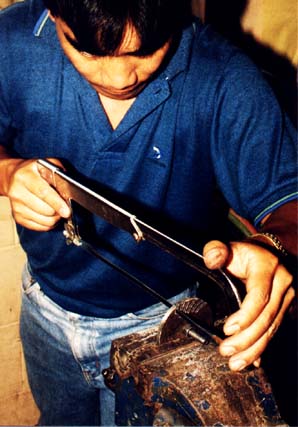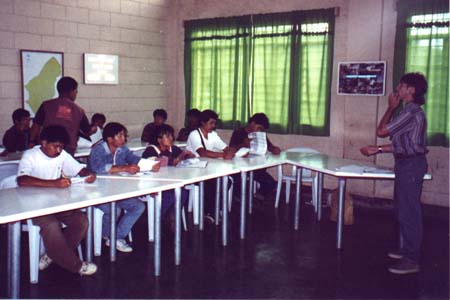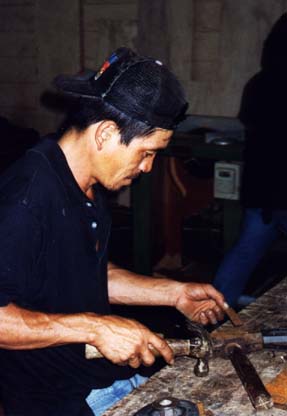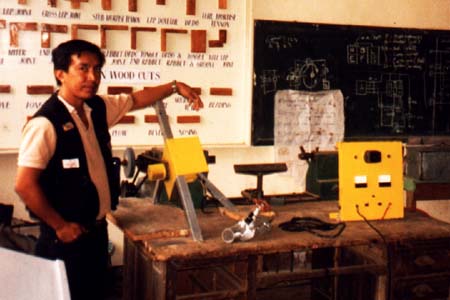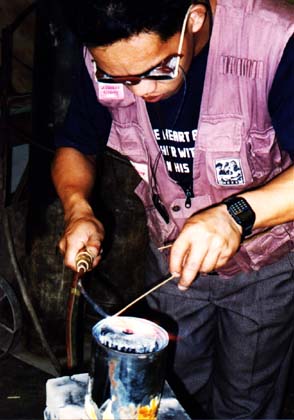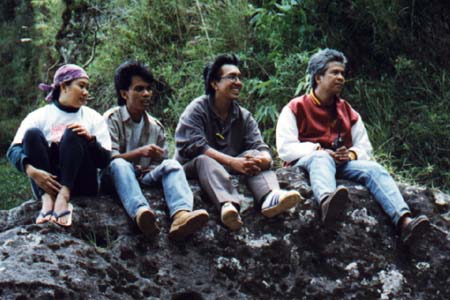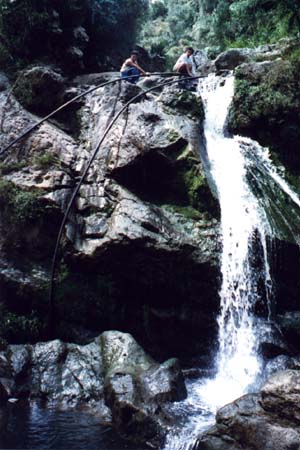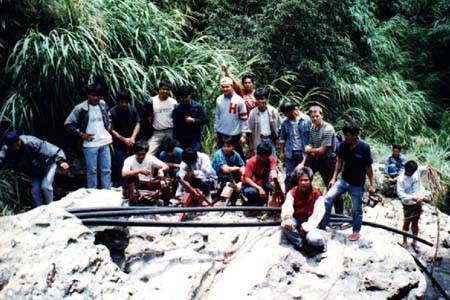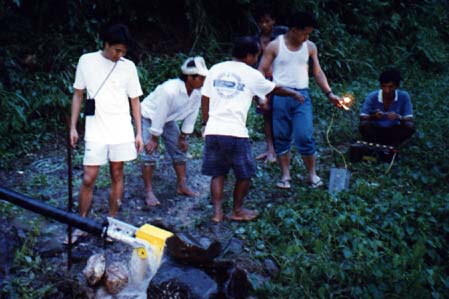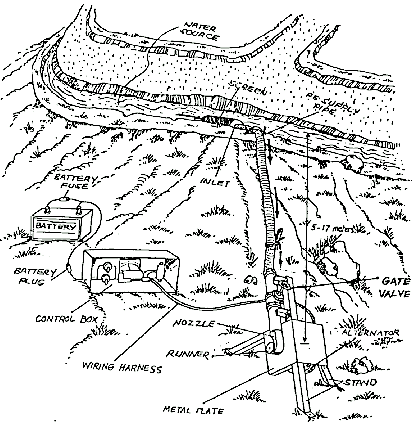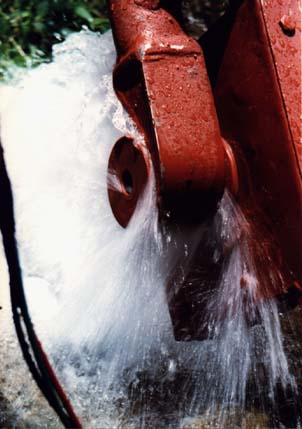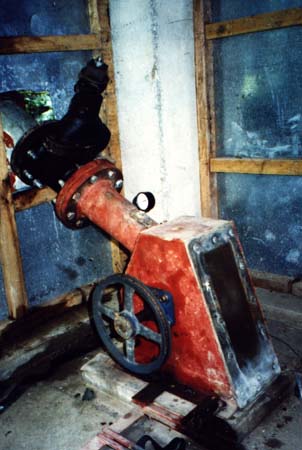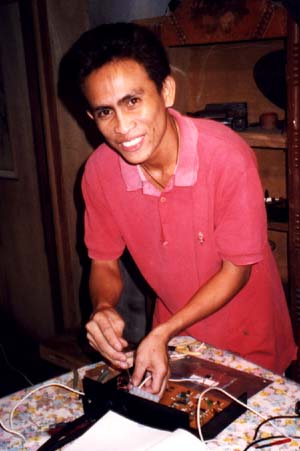| The
commercial approach: Top Ace motor works
My frend Huub Luyk knew Top Ace motor works, a
large metal workshop whose manager, mr. Benito Tiong, was
interested in Micro Hydro. Based on the firefly manual,
mr. Tiong made a price quotation and came up with a very
reasonable price: ca. US$ 150 for the charger without
switchboard. I met mr. Tiong a couple of times and
visited his workshop. Clearly, mr. Tiong was determined
to, and capable of, producing good quality chargers. He
suggested ways to produce the charger cheaper. In the
Philippines, this is not as logic as it seems, as many
business people think from the marketing side and are
primarily interested in finding new ways to sell their
products at a higher price.
|
| Now there was a problem on the demand
side: How could potential customers get in touch with Top
Ace and order a charger so that Top Ace could start
producing a small series. Top Ace would not do "turn-key
firefly projects" so other parties were needed to
advise potential users, help selecting a site, design
civil works, wire up houses, sell batteries at a
reasonable price etc. This is where ideas about good
development projects come into play. I would have loved
Top Ace to produce chargers and make a profit on it. Also
DGIS/DST/ML (the Dutch ODA dept. that funded my mission)
would like a private company to be involved and sell
commodities at realistic prices. I think that mr. John
Malamug, the manager of BSU-ANEC, was in favour of such
contacts with Top Ace. BSU-ANEC received more requests
for demonstration chargers than they could handle
themselves and likely, he will have referred such people
to Top Ace. But I doubt whether it fitted in mr. Angeles
way of working: He wanted "social projects", so
giving away chargers for free. He thought the chargers
they built themselves, were good enough so no need to
improve quality. The firefly building workshops were a
showcase success for them so I don't think that he would
like to put an end to it Also he was used to decide
himself who could be beneficiaries of his M.H. projects,
and not just sell products to customers who were willing
to pay for it. Also for PRRM it would have been a big
step to allow a private company to earn a profit from
their Micro Hydro projects. |
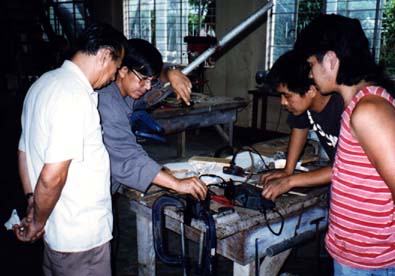
mr. Tiong (left)
looking at my jigs and jigsaw machine for cutting side
disks in series. The other people are, from left to right:
mr. Edgar Molinas, and Jackson ..., both of BSU-ANEC, and
mr. Tiong's assistant
|
| I have not been in touch
with Top Ace motor works since 1996 and I haven't heared
about any chargers being built by them.
A Philippine-wide firefly
introduction project
Besides my work for the ANEC's, I have
tried to establish contacts with other organisations in
the Philippines that could play a role in a future,
Philippine-wide firefly introduction project. At that
moment, it looked like there were possibilities for
substantial funding from DGIS/DST/ML for such a project.
But it never came off the ground:
- I did not find an organisation (or
a group of organisations) that were interested
and capable of planning such a project, applying
for funding and then implementing it.
- Dutch development aid funding was
restructured in such a way that decisions about
funding would be made at Dutch embassies instead
of in The Hague. So getting a project off the
ground was primarily a matter between a
Philippine organisation and the Dutch Embassy. As
a Dutch technical consultant, I could do little
to stimulate that process.
Is the firefly too
cheap?
When I wrote the manual, I hoped that
after some initial technology development and
introduction projects, the firefly technology would
spread by itself. This has not happened: On the whole,
the firefly plays a negligible role in providing energy
services to isolated, rural areas in the Philippines.
Meanwhile, solar energy has been introduced succesfully
in a number of developing countries and I guess the same
has happened in the Philippines. An infrastructure for
supply, installation, maintenance and repair has
developed and prices have come down. A typical Solar Home
System (SHS) consists of a solar panel, Battery Control
Unit, a battery and a few fluorescent lamps. Both the
firefly and a SHS can power about the same types of
appliances. The firefly is more flexible in terms of
energy usage as one could just have the battery recharged
more often if one would like to consume more energy. A
disadvantage of the firefly is that it requires more care
(for checking battery state of charge) and more work (for
bringing the battery to be recharged and collecting it
later).
If one looks at costs, the firefly is
much cheaper: Back in 1992, investment costs per house
for the firefly were about 1/10 of those for a SHS.
Investment costs for a SHS have come down since then and
by now, the firefly will be about 1/5 of a SHS.
Considering this price difference, one would expect that
the firefly would outcompete the SHS in those areas where
suitable sites are abundant and where people are so poor
that spending time is favourable above spending more
money. There must be quite a few such areas in the
Philippines but nowhere the firefly has realy taken off.
This makes one think about other obstacles that hampered
firefly introduction:
- Status: Clearly, a solar
panel on your roof gives another impression to
the neighbours than being seen while carrying
your battery down a slippery mountain trail.
Solar energy is high-tech, clean, shiny, silent
and luxurious while the firefly is second hand
car technology, rusty, muddy, noisy and laborious.
- Technology push: There are
large companies involved in spreading solar
energy. They have built up a supply chain that
reaches out to village level in areas where solar
energy is widespread. To finance uneconomic
demonstration projects in new areas, they have
access to development funds. The firefly will
never be promoted in such a way. In the
Philippines, the biggest car battery supplier
also produced solar batteries for Solar Home
System and was actively promoting solar energy. I
once spoke to their sales manager but he lost
interest when he learned how cheap the firefly
system is. Selling 10 Solar Home Systems and
making a decent profit margin on it, is
worthwhile. Selling one firefly charger, 10
batteries and a bunch of cables is not. They
would have to charge an excessive profit margin
on it to cover the costs of their Manilla-based
staff, customers would be angry when they would
find out and in the end, it would compete with
their solar energy activities. This leads to a
situation where the ones who might want to
introduce the firefly technology, don't have the
capacities and funds to do so while the ones who
could do it, aren't interested because they can
earn more by producing expensive goods for richer
people.
I think those reasons played a major
role in why the firefly technology never took off in the
Philippines. I realize I played a role in it myself: If I
would have been a smarter technician, I might have come
up with a good design earlier and I would have found and
solved all remaining technical issues. If I would have
been a more enthousiastic salesman, I might have gotten
this Philippine-wide introduction project off the ground.
If I would have worked harder... etc. But I doubt whether
that would have made such a difference that these two
obstacles could have been overcome. I am open to
discussion with anyone who thinks differently about this.
index page
|
